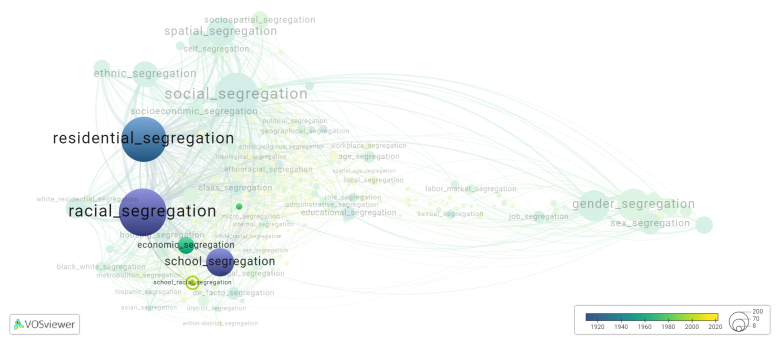School racial segregation
Date and country of first publication[1]
2006
United States
Definition
Racial segregation in schools refers to the separation of students based on their race or ethnicity. This practice was particularly prevalent in the United States during the period of legal segregation known as the Jim Crow era, which lasted from the late 19th century until the mid-20th century.
During this time, laws were implemented that enforced racial segregation in many aspects of life, including education. African American students were often forced to attend separate schools that were typically underfunded, poorly equipped, and staffed by underqualified teachers. These schools were known as "separate but equal" schools, although the reality was that they were far from equal to the schools attended by white students.
The landmark Supreme Court case Brown v. Board of Education in 1954 declared racial segregation in public schools to be unconstitutional. The Court ruled that "separate educational facilities are inherently unequal." This decision was a major victory for the Civil Rights Movement and marked the beginning of efforts to desegregate schools across the United States.
Despite the legal end to racial segregation, de facto segregation in schools still exists in many parts of the United States today. This occurs as a result of residential patterns and socioeconomic inequalities that lead to racially homogenous neighborhoods and, consequently, schools. Efforts to address this issue include policies aimed at promoting diversity and integration in schools, such as busing programs and affirmative action in school admissions.
Synonyms
The following terms are synonymous with school racial segregation:
racial school segregation; school race segregation.
References and literature addressing this segregation form under these synonymous terms can be found below.
See also
Related segregation forms
School racial segregation is frequently discussed in the literature with the following segregation forms:
racial segregation, school segregation, residential segregation, racial residential segregation, income segregation, economic segregation, neighborhood segregation, academic segregation

This visualization is based on the study The Multidisciplinary Landscape of Segregation Research.
For the complete network of interrelated segregation forms, please refer to:
References
Notes
- ↑ Date and country of first publication as informed by the Scopus database (December 2023).
School racial segregation appears in the following literature
Reardon S.F., Yun J.T., Eitle T.M. (2). The changing structure of school segregation: Measurement and evidence of multiracial metropolitan area school segregation, 1989 1995. Demography, 37(3), 351-364. Duke University Press.https://doi.org/10.2307/2648047
Reardon S.F., Yun J.T., Kurlaender M. (2006). Implications of income based school assignment policies for racial school segregation. Educational Evaluation and Policy Analysis, 28(1), 49-75. https://doi.org/10.3102/01623737028001049
Echenique F., Fryer Jr. R.G. (2007). A measure of segregation based on social interactions. Quarterly Journal of Economics, 122(2), 441-485. https://doi.org/10.1162/qjec.122.2.441
Vigdor J.L., Ludwig J. (2008). Segregation and the test score gap. Steady Gains and Stalled Progress: Inequality and The Black-White Test Score Gap, 181-211. Russell Sage Foundation.https://doi.org/
Condron D.J. (2009). Social class, school and non school environments, and black/white inequalities in children's learning. American Sociological Review, 74(5), 683-708. American Sociological Association.https://doi.org/10.1177/000312240907400501
Reardon S.F., Grewal E.T., Kalogrides D., Greenberg E. (2012). Brown Fades: The End of Court Ordered School Desegregation and the Resegregation of American Public Schools. Journal of Policy Analysis and Management, 31(4), 876-904. https://doi.org/10.1002/pam.21649
Ryabov I. (2013). The influence of co racial versus inter racial peer friendships on academic achievement of Asian American adolescents. Asian American Journal of Psychology, 4(3), 201-210. https://doi.org/10.1037/a0029789
Condron D.J., Tope D., Steidl C.R., Freeman K.J. (2013). Racial Segregation and the Black/White Achievement Gap, 1992 to 2009. Sociological Quarterly, 54(1), 130-157. https://doi.org/10.1111/tsq.12010
Brooks J.W., Arnold N.W., Brooks M.C. (2013). Educational leadership and racism: A narrative inquiry into second generation segregation. Teachers College Record, 115(11), -. Teachers College, Columbia University.https://doi.org/
Donnor J.K. (2013). Education as the property of whites: African Americans’ continued quest for good schools. Handbook of Critical Race Theory in Education, 195-203. Taylor and Francis.https://doi.org/10.4324/9780203155721
Flores R.M.V., Scorzafave L.G.D.D.S. (2014). Effect of racial segregation on proficiency of Brazilian elementary school students. EconomiA, 15(1), 20-29. National Association of Postgraduate Centers in Economics, ANPEC.https://doi.org/10.1016/j.econ.2014.03.001
McCardle T. (202). Race Tracks: Career Aspirations and Feelings of Isolation in the Mainstream Classroom. Education and Urban Society, 52(2), 284-311. SAGE Publications Inc..https://doi.org/10.1177/0013124519846277
Oh S.J., Sohn H. (2021). The impact of the school choice policy on student sorting: evidence from Seoul, South Korea. Policy Studies, 42(4), 415-436. Routledge.https://doi.org/10.1080/01442872.2019.1618807
Morris D.S. (2021). Challenging the Stereotype that Minority Segregated Schools are Unsafe: Are Crime and Violence Really More Prevalent in Segregated Minority High Schools?. Race Ethnicity and Education, -. Routledge.https://doi.org/10.1080/13613324.2021.1937093
